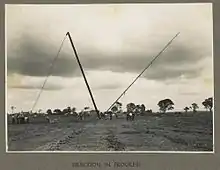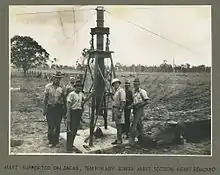Bald Hills, Queensland
Bald Hills is the northernmost suburb of the City of Brisbane, Queensland, Australia.[3] At the 2016 census the suburb recorded a population of 6,502.[1]
| Bald Hills Brisbane, Queensland | |||||||||||||||
|---|---|---|---|---|---|---|---|---|---|---|---|---|---|---|---|
 Harold Kielly Park with ABC Radio Tower | |||||||||||||||
| Population | 6,502 (2016 census)[1] | ||||||||||||||
| • Density | 504.0/km2 (1,305/sq mi) | ||||||||||||||
| Established | 1857 | ||||||||||||||
| Postcode(s) | 4036 | ||||||||||||||
| Area | 12.9 km2 (5.0 sq mi) | ||||||||||||||
| Location | 17 km (11 mi) from Brisbane | ||||||||||||||
| LGA(s) | City of Brisbane (Bracken Ridge Ward)[2] | ||||||||||||||
| State electorate(s) | Sandgate, Aspley | ||||||||||||||
| Federal Division(s) | Petrie | ||||||||||||||
| |||||||||||||||
Geography
Bald Hills is a largely residential suburb. It is mostly surrounded by bushland, but in the last few years some of the bush areas have been cleared to make way for new residential areas. It also borders onto the Bald Hills Flats – a large flood plain on the western side of the suburb that is used for cattle grazing. The South Pine River flows through the flood plain and forms the western border of the suburb. The South Pine River converges with the North Pine River and the combined flow, Pine River, forms the northern border. Along the banks of Pine River within Bald Hills is a large environmental park called the Tinchi Tamba Wetlands Reserve. The Pine River empties into Bramble Bay, between Redcliffe and Brighton.
The Bruce Highway goes between Bald Hills to Woree in Cairns and is 1,656 kilometres (1,029 mi) long.
Demographics
In the 2016 census Bald Hills recorded a population of 6,502 people, 50.8% female and 49.2% male. This indicates an increase of 9% or 537 in population since the 2011 census.[4]
The median age of the Bald Hills population was 36 years of age, 2 years below the Australian median of 38. 76.7% of people living in Bald Hills were born in Australia, compared to the national average of 66.7%; the next most common countries of birth were New Zealand 4%, England 3.4%, Philippines 1.8%, India 1.7%, Fiji 0.7%. 88.8% of people spoke only English at home; the next most popular languages were 0.9% Tagalog, 0.6% Punjabi, 0.6% Spanish, 0.5% Telugu, 0.5% Hindi.[4]
The most common ancestry backgrounds of at least one of the parents for Bald Hills residents were English 27.5%, Australian 26.9%, Irish 7.9%,Scottish 7.7% and German 4.5%.[5]
The median weekly incomes for residents of Bald Hills that are aged 15 years and over is reported to be $725 which is higher than the Australian and Queensland personal incomes (at $662 and $660 respectively). This wealthier than average income is reflected in a higher than average household income for residents of this suburb. In Bald Hills, median household income is $1,584, compared to $1,438 in Australia and $1,402 in Queensland.
History
Bald Hills is situated in the Yugarabul traditional Aboriginal country.[6]
The suburb is named after the two small hills in the South Pine River Valley floor.[3] The first land sales in the area occurred in 1857.[7] Land sales around the Bald Hills railway station were advertised in April 1886. At the time the journey from Brisbane was described as "after travelling across the Downfall and Cabbage Tree Creeks, the traveller arrives at a long stretch of road, at the extremity of which rises a lofty knoll, round the brow of which the road winds, when the Bald Hills are reached".[8] Bald Hills State School opened on 24 September 1866.[9]
Heritage listings
Bald Hills has a number of heritage-listed sites, including:
- 99 Kluver Street: Bald Hills Radiator[10]
- 34 Strathpine Road: Hoop Pines[11]
- 56 Strathpine Road: Bald Hills Presbyterian Church[12]
Landmarks


The most prominent structure is the Bald Hills Radiator, the ABC's 198 metre tall AM radio transmission tower located on the eastern side of the suburb. Bald Hills is the home of the Bald Hills-Lawnton Lions Cricket Club, as well as Ridge Hills United Football Club.
Schools
There are two schools in the suburb, Bald Hills State School, a state primary school and St Paul's School, an Anglican co-educational private school from Pre-Prep to Year 12. Bald Hills Primary School began teaching students in 1866 making it the fourth school to open in the state.[7]
Facilities
Bald Hills is also home to the breeding and training centre for Guide Dogs for the Blind Association of Queensland.
Due to proximity to North Pine River, Bald Hills has a large number of green and open spaces.[13] Parks include, but not limited to:
- Tinchi Tamba Wetlands Reserve (also known as Deepwater Bend Reserve, Pine River Wetlands)
- St Martin Court Park with Shared pathway and water (bubbler/tap)
- Harold Kielly Park with a picnic area and shelter
- John Stewart Memorial Park with Picnic area/shelter with electric barbecue, playground, rebound wall and water (bubbler/tap)
- Harold Kielly Park with Picnic area/shelter with electric barbecue, playground and shared pathway
- Chris Brunton Park (previously known as Hoyland Street Park (no. 6)) with Outdoor fitness/exercise circuit, picnic area/shelter and water (bubbler/tap)
- Canterbury Park with Designated drone launching area, barbecue (electric), bikeway, dog off-leash area, outdoor fitness/exercise trail, basketball/netball facility (basketball half court), picnic area/shelter (Rush Worth Street), playground (Rush Worth Street), water (bubbler/tap/dog bowl), wetlands (Feuerriegel Road) and cricket field
- Barungwarra Bushland Reserve (South Pine Pocket Reserve) with Boat ramp (Pine River), dog off-leash area and vehicle access
Transport
Bald Hills railway station provides access to regular Queensland Rail City network services to Brisbane and Springfield Central, as well as Kippa-Ring. There are also many buses serving the area. The suburb is crossed by both Gympie Road and the northern end of the Gateway Motorway. The southern end of the Bruce Highway is located here as well.
Brisbane City Council runs a Personalised Public Transport (PPT) service in Bald Hills.[14] Personalised Public Transport (PPT) is a low-cost hail and ride service that helps connect residents to their local transport hubs. This service runs Monday to Friday, except public holidays. Maximum journey time one-way is 15 minutes.
There are over 50 Translink bus stops around Bald Hills that provide a number of regular bus services with connections running to Brisbane CBD, Redcliffe and beyond.
References
- Australian Bureau of Statistics (27 June 2017). "Bald Hills (Qld)". 2016 Census QuickStats. Retrieved 25 March 2018.

- "Bracken Ridge Ward". Brisbane City Council. Brisbane City Council. Archived from the original on 4 February 2017. Retrieved 12 March 2017.
- "Bald Hills (entry 46574)". Queensland Place Names. Queensland Government. Retrieved 20 March 2014.
- Australian Bureau of Statistics (27 June 2017). "Bald Hills (SSC)". 2016 Census QuickStats. Retrieved 22 June 2019.

- "2016 Census QuickStats – Bald Hills, Queensland". abs.gov.au. Australian Bureau of Statistics. Archived from the original on 4 February 2020. Retrieved 4 February 2020.
- "AIATSIS code E66: Yugarabul". Federal government. Australian Institute of Aboriginal and Torres Strait Islander Studies. Retrieved 31 July 2020.
- Brian Williams (31 October 2013). "Secrets of Brisbane's suburbs: B". The Courier Mail. News Corp. Retrieved 20 October 2016.
- "The Brisbane Courier Saturday 10 April 1886 - The Railway Estate". Archived from the original on 6 December 2017. Retrieved 6 December 2017.
- "Opening and closing dates of Queensland Schools". Queensland Government. Retrieved 18 April 2019.
- "National Broadcasting Service Radio Transmission Centre". Brisbane Heritage Register. Brisbane City Council. Retrieved 29 December 2014.
- "Hoop Pines (entry 602346)". Queensland Heritage Register. Queensland Heritage Council. Retrieved 6 July 2013.
- "Bald Hills Presbyterian Church". Brisbane Heritage Register. Brisbane City Council. Retrieved 29 December 2014.
- "Bald Hills parks". www.brisbane.qld.gov.au. Brisbane City Council. Archived from the original on 22 June 2019. Retrieved 22 June 2019.
- "Personalised Public Transport". www.brisbane.qld.gov.au. Brisbane City Council. Archived from the original on 22 June 2019. Retrieved 22 June 2019.
External links
| Wikimedia Commons has media related to Bald Hills, Queensland. |
- Bald Hills: Queensland Places
- Bald Hills State School website
- "Bald Hills". BRISbites. Brisbane City Council. Archived from the original on 20 July 2008.
- "Bald Hills". Our Brisbane. Brisbane City Council. Archived from the original on 20 February 2008.
- Sandgate (Bald Hills) cemetery, Bracken Ridge
- Bald Hills State School
- "Local History - Bald Hills". Australian Broadcasting Corporation. 6 May 2009.